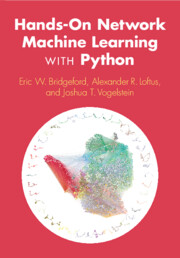Book contents
- Frontmatter
- Contents
- Preface
- Terminology
- Part I Foundations
- Part II Representations
- 3 Characterizing and Preparing Network Data
- 4 Statistical Models of Random Networks
- 5 Learning Network Representations
- Part III Applications
- Appendix A Network Model Theory
- Appendix B Learning Representations Theory
- Appendix C Overview of Machine Learning Techniques
- Index
5 - Learning Network Representations
from Part II - Representations
Published online by Cambridge University Press: 23 September 2025
- Frontmatter
- Contents
- Preface
- Terminology
- Part I Foundations
- Part II Representations
- 3 Characterizing and Preparing Network Data
- 4 Statistical Models of Random Networks
- 5 Learning Network Representations
- Part III Applications
- Appendix A Network Model Theory
- Appendix B Learning Representations Theory
- Appendix C Overview of Machine Learning Techniques
- Index
Summary
This chapter presents a framework for learning useful representations, or embeddings, of networks. Building on the statistical models from Chapter 4, we explore techniques to transform complex network data into vector representations suitable for traditional machine learning algorithms. We begin with maximum likelihood estimation for simple network models, then motivate the need for network embeddings by contrasting network dependencies with typical machine learning independence assumptions. We progress through spectral embedding methods, introducing adjacency spectral embedding (ASE) for learning latent position representations from adjacency matrices, and Laplacian spectral embedding (LSE) as an alternative approach effective for networks with degree heterogeneities. The chapter then extends to multiple network representations, exploring parallel techniques like omnibus embedding (OMNI) and fused methods such as multiple adjacency spectral embedding (MASE). We conclude by addressing the estimation of appropriate latent dimensions for embeddings. Throughout, we emphasize practical applications with code examples and visualizations. This unified framework for network embedding enables the application of various machine learning algorithms to network analysis tasks, bridging complex network structures and traditional data analysis techniques.
Keywords
Information
- Type
- Chapter
- Information
- Hands-On Network Machine Learning with Python , pp. 189 - 256Publisher: Cambridge University PressPrint publication year: 2025
Accessibility standard: WCAG 2.1 A
Why this information is here
This section outlines the accessibility features of this content - including support for screen readers, full keyboard navigation and high-contrast display options. This may not be relevant for you.Accessibility Information
Content Navigation
Allows you to navigate directly to chapters, sections, or non‐text items through a linked table of contents, reducing the need for extensive scrolling.
Provides an interactive index, letting you go straight to where a term or subject appears in the text without manual searching.
Reading Order & Textual Equivalents
You will encounter all content (including footnotes, captions, etc.) in a clear, sequential flow, making it easier to follow with assistive tools like screen readers.
You get concise descriptions (for images, charts, or media clips), ensuring you do not miss crucial information when visual or audio elements are not accessible.
